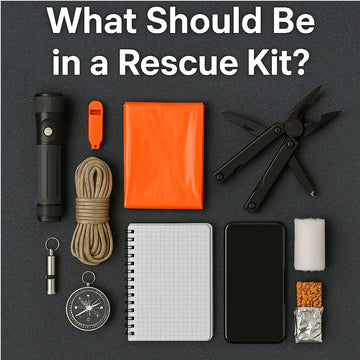Emergencies don't wait. Whether you're hiking in the wilderness, facing a flood, or responding to an accident, having a well-prepared rescue kit can make all the difference.
But what exactly should go into a rescue kit? It’s not just about bandages or flashlights—it’s about survival, safety, and being ready to act when it matters most.
In this guide, we’ll walk you through the essential items every rescue kit should include, from the basics to advanced gear. Whether you’re a professional responder or a cautious adventurer, this list is your starting point.
Why a Rescue Kit Matters
The ancient proverb says, “Fortune favors the prepared.” In emergency situations—be it natural disasters, accidents, or unexpected breakdowns—being prepared with the right tools could save your life or someone else's.
Modern rescue kits are more than just first aid—they’re comprehensive life-saving systems designed for quick response in high-stress situations.
1. Basic First Aid Supplies
At the core of every rescue kit is a first aid kit. It should include:
-
Adhesive bandages (various sizes)
-
Sterile gauze pads and rolls
-
Antiseptic wipes and antibiotic ointment
-
Tweezers and scissors
-
Medical gloves (non-latex)
-
Pain relievers (like ibuprofen or aspirin)
-
CPR face shield or mask
For minor injuries or stabilizing someone until help arrives, these items are a must-have.
💡 Tip: Check your first aid supplies every 6 months for expired medications or depleted items.
2. Survival and Shelter Tools
In situations where you’re stranded or waiting for rescue, staying warm and protected is key. Include:
-
Mylar emergency blankets (space blankets)
-
Ponchos or raincoats
-
Multi-tool or Swiss Army knife
-
Rope or paracord
-
Waterproof matches or a lighter
-
Portable shelter (foldable tarp or bivy sack)
These tools help prevent hypothermia and protect you from the elements.
3. Communication and Signaling Devices
Being found quickly depends on your ability to signal for help. Your rescue kit should have:
-
Emergency whistle
-
Flashlight or headlamp (with extra batteries)
-
Reflective mirror or signaling panel
-
Fully charged power bank
-
Two-way radio or satellite communicator (especially in remote areas)
In water-based rescues or disasters, drones like the JX-6A Air-Water Rescue Drone have also been used to deliver communication gear and locate stranded individuals using real-time camera feeds.
4. Food and Water Essentials
You may need to wait hours—or even days—for help. Stock these essentials:
-
Water purification tablets or straw filter
-
Collapsible water bottle
-
High-energy snacks (granola bars, trail mix, protein bars)
-
Electrolyte packets
Hydration and nutrition help maintain energy levels, especially in extreme weather or while assisting others.
5. Tools for Specific Environments
Depending on where you are—urban, rural, mountains, or sea—your kit should be tailored accordingly.
For water rescue:
-
Life jacket or throw rope
-
Inflatable flotation device
-
Waterproof dry bag
-
Rescue drone like the JX-6A – which can deliver floatation (190N buoyancy), hover steadily in Level 6 winds, and stream live video from the scene.
For vehicle emergencies:
-
Glass breaker and seatbelt cutter
-
Jumper cables
-
Flares or reflective triangles
-
Tire repair kit and air pump
6. Documentation and Identification
Include copies of important info, stored in a waterproof pouch:
-
Personal ID and emergency contact card
-
List of allergies or medical conditions
-
Local emergency numbers
-
Area map (in case GPS fails)
Final Checklist: 10 Must-Have Items in Every Rescue Kit
-
First Aid Kit
-
Flashlight or Headlamp
-
Emergency Blanket
-
Whistle
-
Water Purifier
-
Power Bank
-
Multi-tool
-
Signaling Mirror
-
Non-perishable Food
-
Rope or Paracord
Final Thoughts
A rescue kit is like insurance—you hope you never need it, but when you do, it’s priceless. Whether you’re camping, working in emergency response, or just want to protect your family, building the right rescue kit is a responsible and empowering step.
As technology advances, even tools like the JX-6A rescue drone are becoming essential parts of modern emergency response—bringing speed, safety, and efficiency to high-risk rescues.
“Prepare today, survive tomorrow.”
Stay ready, stay safe.





